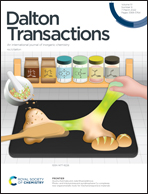Computational investigation into intramolecular hydrogen bonding controlling the isomer formation and pKa of octahedral nickel(ii) proton reduction catalysts†
Abstract
This work demonstrates the impact of intramolecular hydrogen bonding (H-bonding) on the calculated pKa of octahedral tris-(pyridinethiolato)nickel(II), [Ni(PyS)3]−, proton reduction catalysts. Density Functional Theory (DFT) calculations on a [Ni(PyS)3]− catalyst, and eleven derivatives, demonstrate geometric isomer formation in the protonation step of the catalytic cycle. Through Quantum Theory of Atoms in Molecules (QTAIM), we show that the pKa of each isomer is driven by intramolecular H-bonding of the proton on the pyridyl nitrogen to a sulfur on a neighboring ligand. This work demonstrates that ligand modification via the placement of electron-donating (ED) or electron-withdrawing (EW) groups may have unexpected effects on the catalyst's pKa due to intramolecular H-bonding and isomer formation. These factors need to be considered in computational work. This work suggests the possibility that modification of substituent placement on the ligands to manipulate H-bonding in homogeneous metal catalysts could be explored as a tool to simultaneously target both desired pKa and E° values in small molecule catalysts.



 Please wait while we load your content...
Please wait while we load your content...